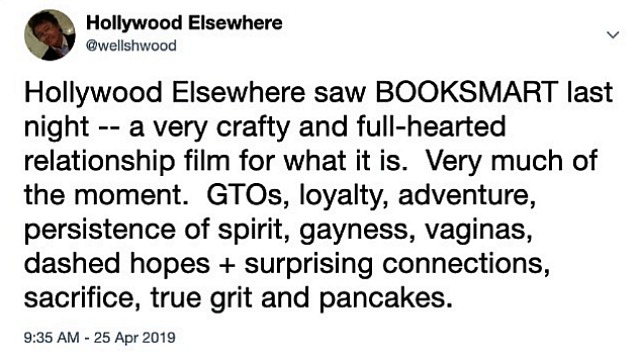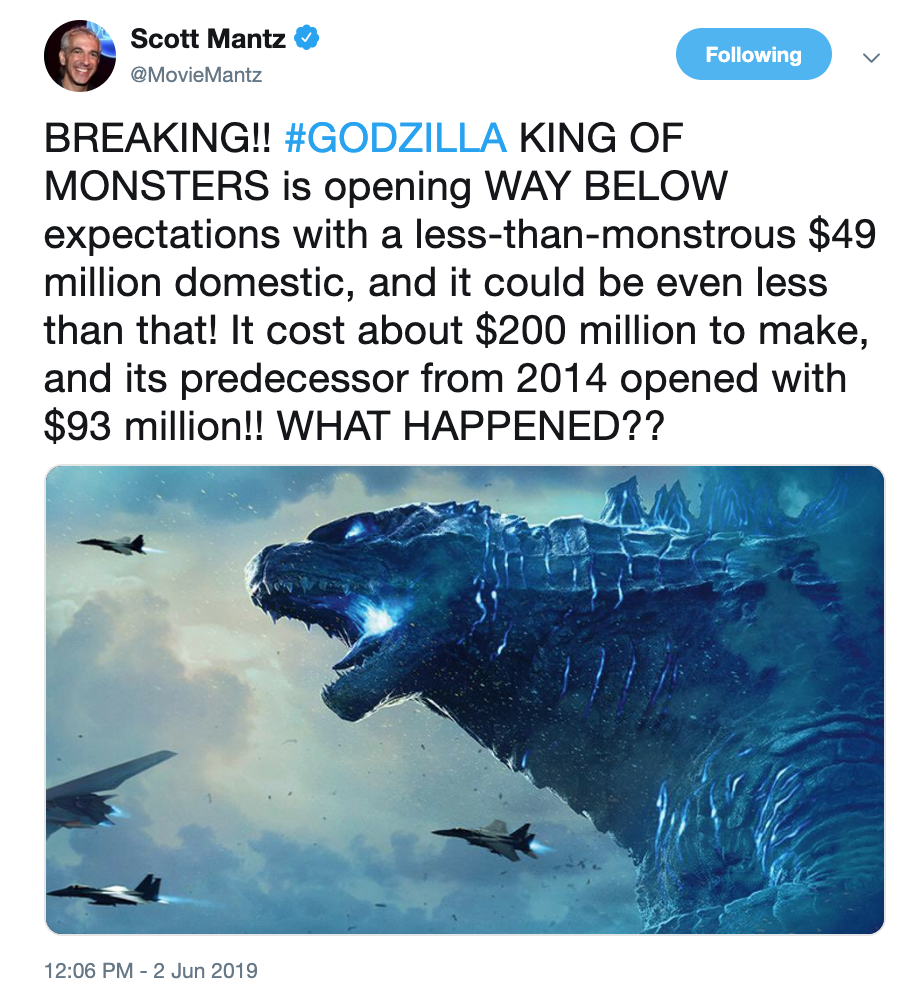


Yesterday HE commenter “Jax” wrote the following assessment of Booksmart: “Just saw this. Breaking news: IT’S NOT THAT FUNNY. Sarcasm and snark [which] all the new comedies have, but no real wit, and no real dramatic tension between the leads until the end. The scene with the dolls was GREAT, but you can’t make a movie out of that.
“Plus the film is a wolf in sheep’s clothing. It’s been talked up on the chat shows as a great coming-of-age comedy a la American Graffiti or Fast Times at Ridgemont High. Actually it’s a crypto lesbian comedy with a semi-hot lovemaking scene (with a gross joke) and a strong feeling for the sisterhood of two young women. Not what the audience signed up for.”
I’m sorry but the instant that I read “crypto lesbian comedy” I had to admit that this label is somewhat on-target, at least when you compare the actual content of Booksmart vs. how it’s been sold.

I happened to enjoy Booksmart for what it is (partly because it seems to be reflecting late-teen mores and attitudes among GenZ types in big-city cultures) but I also refrained from describing it as a semi-lesbian thing, as did almost every other critic in the world.
Because anything more than a cursory mention of a gay current can lead to wokester-wolf-pack suspicions of vague homophobia, so the smart thing is to discreetly allude to a film’s sexual atmosphere without saying “this is what it is”.
Which is why you’ll never read the term “crypto lesbian comedy” or anything like that from anyone who writes for Indiewire, the official journal of wokester politics and attitudes.
The marketing of Booksmart, in short, played the old “hide the ball” game — selling it as an edgy, whipsmart teen odyssey (which I for one bought into, having said it was “as fulfilling and well-honed as a 21st Century high-school farewell thing could reasonably be”) when in fact it’s a little gayer than what anyone has officially copped to.
Another thing we’re not allowed to mention these days is the fact that the LGBTQ community reps 4.5% of the U.S. population. Add your enlightened urban/suburban liberals and wokesters and the core allegiance factor is still on the marginal side.
Name some other significant “hide the ball” marketing campaigns, whether or not they resulted in a film’s commercial success.
Race-track flicks are naturally about serious pro-level drivers and their vehicles. (Renegade fast-car movies are a different breed.) The most enjoyably immersive race-track flicks, in this order: Claude Lelouch‘s Rendezvous (not shot on a track but all the more thrilling for that), John Sturges and Steve McQueen‘s Le Mans (the failure of which marked the end of McQueen’s superstar phase), Lamont Johnson‘s The Last American Hero, John Frankenheimer‘s Grand Prix, James Goldstone‘s Winning, Tony Scott‘s Days of Thunder, Ron Howard‘s Rush, the Fred Astaire race-car sequence in On The Beach.
Last weekend Joe and Jane Popcorn stood eyeball-to-eyeball with Warner Bros. and Legendary Pictures and said the following: “You can’t keep Monsterverse-ing us with the same old Godzilla crap and expect lines around the block. We’re not going to sit for this stuff endlessly, on top of which your new Godzilla is at least a couple of tons heavier than the five-year-old Gareth Edwards version…the first flat-out obese monster in the history of motion pictures. We’re fat enough on our own, bruhs — we’d rather not be reminded of the obesity epidemic when we go to the movies.”
Yes, I’m kidding. Mostly. But Godzilla: King of the Monsters did under-perform last weekend.
Variety‘s Rebecca Rubin: “Godzilla: King of the Monsters didn’t have a roar quite as deafening as its franchise predecessors. The third entry in Warner Bros. and Legendary’s MonsterVerse opened with a middling $49 million at the domestic box office, a start well below 2014’s Godzilla ($93 million) and 2017’s Kong: Skull Island ($61 million).
“Like its series brethren, Godzilla’s umpteenth return to the big screen had a more promising start overseas, where it debuted with $130 million. Even so, that’s a potentially problematic drop in ticket sales for a movie that cost roughly $200 million to make. It also likely required a marketing spend in excess of $100 million.

This is a mildly cruddy kinescope of a 4.8.55 Person to Person segment in which the 47-year-old Edward R. Murrow interviewed Marilyn Monroe, who was then 28. She was staying at the Connecticut home of celebrity photographer and producer Milton Greene, who had photographed her many times and with whom she had formed a production company. Monroe’s appearance (along with Greene’s wife Amy) begins at 3:30.
Even though she’s “acting” (as anyone sitting for an on-camera interview would do) and particularly the inaccurate but well-known part of the less-than-robustly-intellectual blonde who nonetheless tries like hell, there’s something emotionally devastating about Monroe’s eyes, personality, manner, looks…the whole package.
Yes, this observation has been shared tens of millions of times but something extra is going on in this interview, I swear. Very political and practiced and polite, a sly sense of humor, but the delicate sensitivity and especially the vulnerability…God. The way she occasionally takes a beat to collect her thoughts, and sometimes speaks slowly and cautiously, drawing on a sufficient but less-than-vast vocabulary. Try not to succumb.
Wiki excerpt: “Greene’s work with Monroe (whom he first shot for a layout for Look in 1953) changed the course of his career. The two struck up a friendship and, when Monroe left Los Angeles to study acting with Lee Strasberg in New York City, she stayed with Greene, his wife Amy and young son Joshua in Connecticut. Together with Greene, Monroe formed Marilyn Monroe Productions, a production company in an effort to gain control of her career. Greene would go on to produce Bus Stop (’56) and The Prince and the Showgirl (’57).
“Monroe and Greene’s friendship ended after the production of The Prince and the Showgirl, and [then] Monroe fired Greene.”